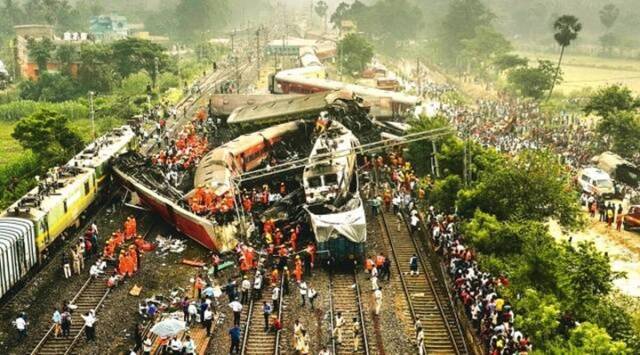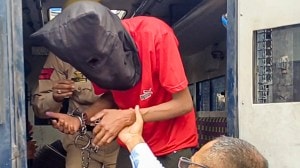Balasore Coromandel Express accident CRS report: Wrong labelling of location box wires led to mix-up
While the signalling department has been found to be primarily responsible, the station master, who is part of the operations department, has also been named for failing to detect “abnormal behaviour” of the signalling control system that could have prevented the tragedy.
 Locals, security personnel and NDRF during the search and rescue operation at the site where Coromandel, Bengaluru-Howrah Express trains derailed. (File)
Locals, security personnel and NDRF during the search and rescue operation at the site where Coromandel, Bengaluru-Howrah Express trains derailed. (File) Pointing out “lapses at multiple levels”, the investigation by the Commissioner of Railway Safety (CRS) into the train accident near Balasore in Odisha on June 2, in which at least 293 people were killed, has found that wrong labelling of wires inside the level-crossing location box remained undetected for years and ultimately led to a mix-up during maintenance work. It has said that the tragedy could have been averted if past red flags were not ignored.
 While the signalling department has been found to be primarily responsible, the station master, who is part of the operations department, has also been named for failing to detect “abnormal behaviour” of the signalling control system that could have prevented the tragedy.
While the signalling department has been found to be primarily responsible, the station master, who is part of the operations department, has also been named for failing to detect “abnormal behaviour” of the signalling control system that could have prevented the tragedy.According to the CRS report, which was submitted to the Railway Board last week, the signalling staff at the site said that while carrying out replacement work of the ‘electric lifting barrier’ at the level crossing on the day of the accident, they were “misled” by “anomalies” like wrong lettering on the terminal, and the circuit that showed the position of the ‘point’ (the motorised part that guides a train from one track to another) had been shifted in the past.
 Railways Minister Ashwini Vaishnaw overseeing the restoration work at the accident spot in Odisha’s Balasore. (Express photo by Partha Paul)
Railways Minister Ashwini Vaishnaw overseeing the restoration work at the accident spot in Odisha’s Balasore. (Express photo by Partha Paul)
The location box, where these wires were connected, contained wrong lettering, which means they wrongly indicated the functions. The CRS probe found that as early as in 2015, the completion wiring diagram – to show technicians how the wiring is meant to be reconnected after maintenance work — was changed on paper and duly approved. But the change of labelling was not done physically. “However, the circuit names… were not corrected on the terminal rack,” the report says.
The CRS report called it “wrong lettering; old one not corrected”.
Again, in 2018, the position of the circuit that detects the status of the ‘point’ was shifted within the location box, but the change was not labelled accordingly – neither on the diagram, not at the cable terminal rack, the CRS said.
The wiring diagram of another location box in Balasore was used for the Bahanaga Bazar location box. “This was a wrong step that led to wrong wiring,” said the report.
According to the report, there were indications of anomalies in the system. When the station master, who controls the signals for train operations, gave the command to reverse the ‘point’ from ‘loop line’ to normal ‘Up line’ for the Coromandel Express barely 10 minutes before the accident, the indication of that change came instantly, instead of after a few seconds. “This was the most abnormal occurrence as change of status of a ‘point’ was supposed to take 13-14 seconds,” said the report, adding that this was because of the “false feed” the system was getting due to faulty wiring.
“This abnormal occurrence should have been noticed by the station master as it occurred during individual operation and he was aware of the normal time required for the operation of a ‘point’ (7 to 15 seconds) which he had mentioned suo motu in the inquiry. The station master should have brought this abnormality to the notice of the signalling staff working there, and should not have taken off ‘Up Home’ Signal for the train,” says the report.
While the signalling staff continued to carry out maintenance work even after furnishing a “reconnection memo”, which means the electronic interlocking signalling system was live again, they told the CRS that the work was not linked to train signalling.
The CRS has also found that about two weeks before the accident, the Kharagpur division had a similar incident at Bankra Nayabaz station, due to wrong wring and cable fault. “Had corrective measures been taken after this incident, to address the issue of wrong wiring, the accident at Bahanaga Bazar station would not have occurred,” the CRS has said.
In one of the worst train accidents in recent years, the Shalimar-Chennai Coromandel Express, on June 2, entered the ‘loop line’ of the Bahanaga Bazar station instead of its designated main line, and rammed into a stationary goods train. The train derailed and parts of it hit another train, the Bengaluru-Howrah Superfast, which also derailed, resulting in high casualty figures.
The Coromandel Express had a green signal for the main line but the ‘point’, or the mechanism that determines the direction of a train, remained wrongly directed to the ‘loop line’, causing the accident.
CRS South Eastern Circle A M Chaudhary did not respond to calls; a Railway Board spokesman said the report will be examined.












